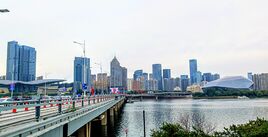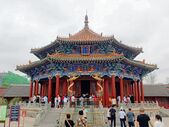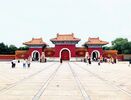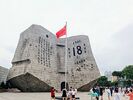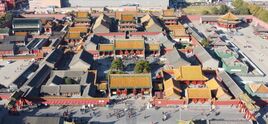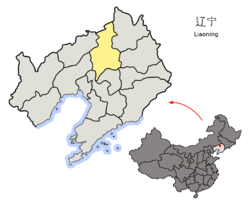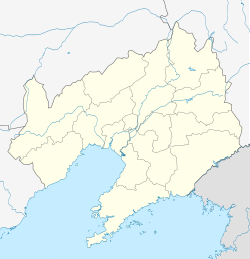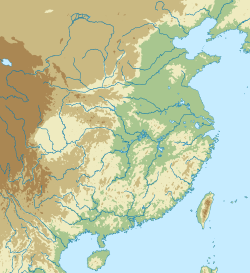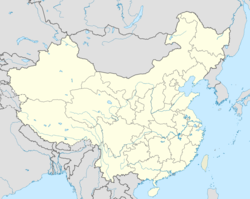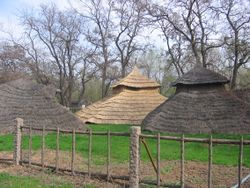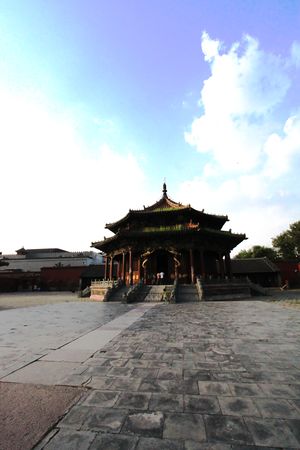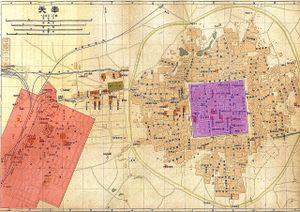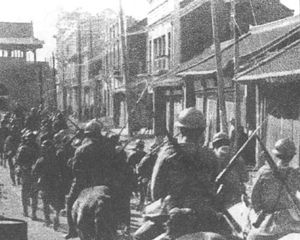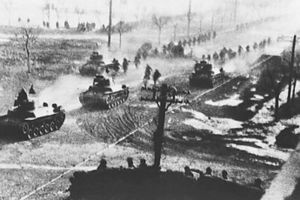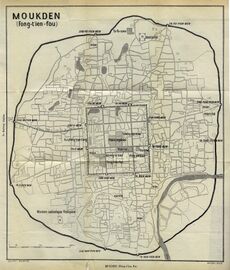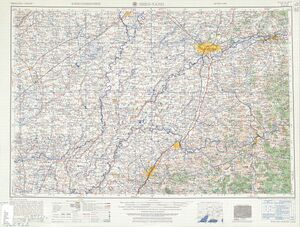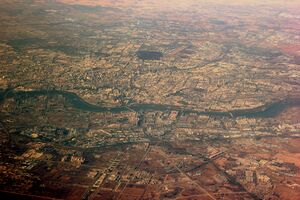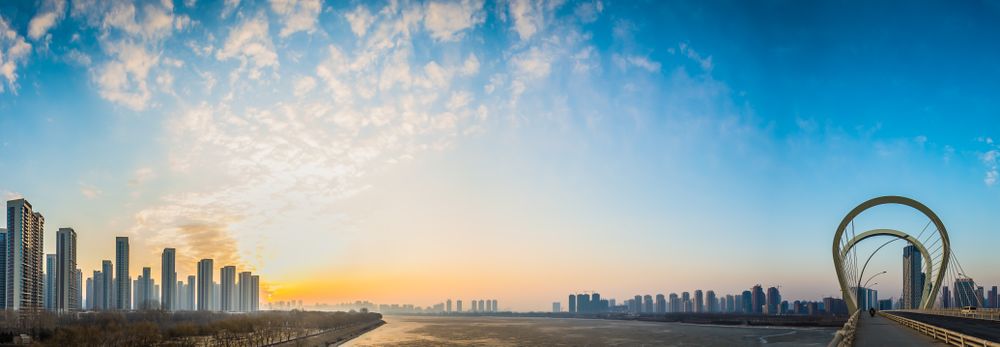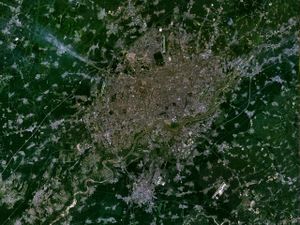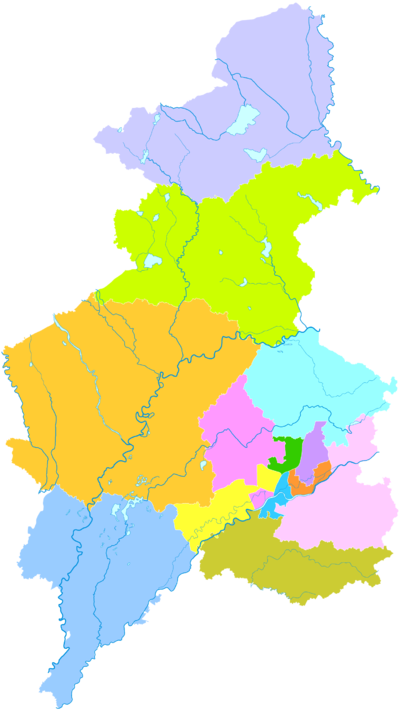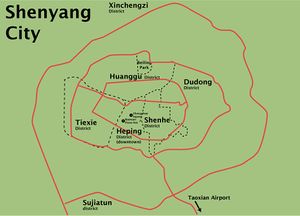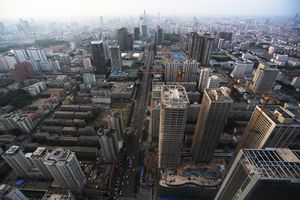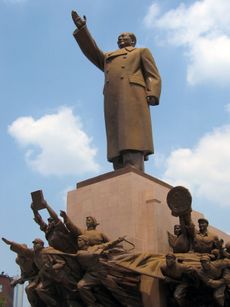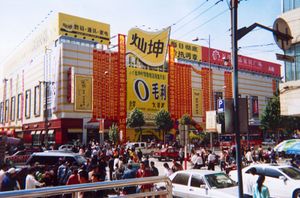شنيانغ
| ||||||||||||||||||||||||||||||||||||||||||||||||||||||||||||||||||||||||||||||||||||||||||
| ||||||||||||||||||||||||||||||||||||||||||||||||||||||||||||||||||||||||||||||||||||||||||
شنيانگ ( Shenyang ؛ الصينية المبسطة: 沈阳؛ الصينية التقليدية: 瀋陽؛ پنين: Shěnyáng�؛ نطق المندرينية: [ʂə̀n.jɑ̌ŋ]), كانت تُعرف سابقاً بإسم Fengtian (صينية: 奉天�, النطق المندريني: [fə̂ŋtʰján]) أو بإسمها المانشو، مـُكـْدِن Mukden ، IPA:/mukʰ.tən/) هي مدينة دون المقاطعة في الصين وعاصمة مقاطعة لياوننگ في شمال وسط لياوننگ. وتسمى أيضًا موكدن. تشكل مركزا لتجمع حضري يضم العديد من المدن الأخرى. بلغ عدد سكانها 9,070,093 نسمة في 2020.[4] تعتبر "شنيانگ" مدينة صناعية شاملة وهمزة ربط للمواصلات وأكبر مدن شمال شرق الصين، حسب التعداد الحضري، وقاعدة وطنية لإنتاج الماكينات والأجهزة المتقدمة، تحتل صناعات الطائرات والسيارات الخفيفة ونقل وتحويل الكهرباء بها مكانة هامة في البلاد.[5][6]
تقع في منشوريا على ضفة نهر هون، وتتوسط أكثر المناطق كثافة سكانية في منشوريا، حيث يبلغ عدد سكانها 4,130,000 نسمة. تتقابل في شنيانج خمسة خطوط للسكك الحديدية، وبها ثلاثة مطارات. وتنتج مصانعها المنتجات المعدنية والآلات والمعدات والطائرات.
وقد بُنِي المركز، وهو أقدم أجزاء شنيانگ، أثناء العصور الوسطى. ويتميز بشوارعه الضيقة ومبانيه القديمة، كما تُحيط به جدران حجرية عالية. ويقع خارج هذا الجزء المربع الروسي، الذي بناه الروس في أوائل سنوات القرن العشرين، عندما احتلوا شنيانگ. وقد أنشأ اليابانيون العديد من الضواحي للمصانع والمنازل عندما غزوا منشوريا في عام 1931. وشمال شنيانگ حديقة جميلة تحتوي على مقابر الأباطرة المانشو الذين حكموا الإمبراطورية الصينية المترامية.
شنيانگ هي المدينة المركزية لواحدٍ من المدن الكبرى في الصين، منطقة شنيانگ الكبرى العمرانية، بتعداد يزيد عن 23 مليون نسمة. المنطقة الإدارية للمدينة تضم عشر مديريات عمرانية لشنيانگ، المدينة بمستوى ناحية شينمين، وناحيتين: كانگپينگ و فاكو.
مرت شنيانگ بعهود من سيطرة العديد من الدول والشعوب في التاريخ. ففي القرن 14، وقعت شنيانگ تحت سيطرة أسرة مينگ. وكانت المدينة معقلاً عسكرياً صينياً مهماً خلال فترة مينگ. في القرن 17، انتزع المانشو شنيانگ من أيدي المينگ، واستخدموها لفترة وجيزة كعاصمة لأسرة تشينگ الصينية.[7] وفي 1905، نشبت معركة موكدن جنوب شنيانگ أثناء الحرب الروسية اليابانية. سمح الانتصار التالي لليابان لطوكيو أن تضم المنطقة غرب المدينة القديمة وأن توسع من النفوذ الياباني على شنيانگ؛ في 1931، أدى حادث موكدن أن يقوم اليابانيون بالمزيد من الغزو واحتلال باقي شمال شرق الصين، مشكّلة الدولة الدمية مانشوكو. بعد استسلام اليابانيين في 1945، بقيت شنيانگ معقلاً للكومنتانگ، ولكن الشيوعيون استولوا عليها في 1948 بعد حملة لياوشن.
Along with its nearby cities, Shenyang is an important industrial center in China,[8] and serves as the transportation and commercial hub of China's northeast—particularly involved in links with اليابان وروسيا وكوريا.[9] A center of heavy industry in China since the 1930s, and the spearhead of the Chinese central government's Northeast Area Revitalization Plan,[10] the city has been diversifying its industry, including expanding into the service sector. Growing industries include software, automotive and electronics.
Shenyang is also a major city for scientific research, appearing among the top 200 science cities in the world as tracked by the Nature Index.[11] تضم المدينة العديد من الجامعات الكبيرة، أبرزهم الجامعة الشمالية الشرقية وجامعة لياوننگ، العضوين في الجامعات الراقية بالصين في خطة جامعات الدرجة الأولى بإزدواج.
. . . . . . . . . . . . . . . . . . . . . . . . . . . . . . . . . . . . . . . . . . . . . . . . . . . . . . . . . . . . . . . . . . . . . . . . . . . . . . . . . . . . . . . . . . . . . . . . . . . . . . . . . . . . . . . . . . . . . . . . . . . . . . . . . . . . . . . . . . . . . . . . . . . . . . . . . . . . . . . . . . . . . . . .
الاسم
شنيانگ تعني حرفياً "جانب الـ يانگ لنهر شن" ويشير إلى موقع نهر هون (الذي كان يُدعى سابقاً نهر شن، 瀋水؛ Shěn Shuǐ�)، على الجانب الجنوبي للمدينة. وحسب تقليد التسمية الصيني، فإن الضفة الشمالية لنهر والسفح الجنوبي لجبل يميلان أكثر باتجاه ضوء الشمس المباشر ولذلك يُعتبرا الجانب "المشمس"، أو "يانگ".[12]
التاريخ
اسم المدينة، شنيانگ، يعني حرفياً "المدينة إلى الشمال من نهر شن"، في إشارة إلى نهر هون على الجانب الجنوبي للمدينة، والذي كان يسمى نهر شن. وتدل اللقى الأثرية على أن البشر استقروا في ما هو اليوم شنيانگ منذ 7,200 سنة، على الأقل. مدينة شنيانگ أسسها لأول مرة چين كاي، القائد العسكري في يان في فترة الدويلات المتناحرة حوالي 300 ق.م. وقد سُميت مدينة هو (بالصينية: 候城 ، Hou) حينذاك. وأصبحت تُعرف بإسم محافظة شن (瀋州) في أسرة جين و "درب شنيانگ" (بالصينية: 瀋陽路) في أسرة يوان. وأثناء أسرة مينگ أصبحت شنيانگ ژونگوِيْ (بالصينية: 瀋陽中衛).
في 1625، نقل زعيم المانشو، نورحاجي، عاصمته إلى شنيانگ، أو سيمييان هوتون كما تُسمى بلغة المانشو. الاسم الرسمي تغير إلى شنگجينگ (盛京) بالصينية، أو Mukden ![]() بالمانشو، في 1634. الاسم مشتق من كلمة بلغة المانشو، mukdembi، وتعني "ينهض"، وينعكس ذلك المعنى في الاسم الصيني، الذي يعني "العاصمة الناهضة". وقد ظلت شنيانگ عاصمة أسرة تشينگ حتى انتقال العاصمة إلى بـِيْجينگ في 1644 بعد سقوط أسرة مينگ. إلا أنها احتفظت بمكانة معتبرة كالعاصمة القديمة، وكنوز البيت الملكي حـُفِظت في قصورها، ومقابر الحكام المبكرين لأسرة تشينگ كانت تُعتبر في وقتٍ ما أبرز المعالم في الصين. وفي 1657، تأسست محافظة فنگتيان (بالصينية: 奉天府; پنين: Fèngtiān fǔ ؛ بالمانشو: Abkai imiyangga fu أو Fungtyian، "مطيعة السماء") في منطقة شنيانگ، وأحياناً كان فنگتيان تستخدم كمرادف لكلمتي شنيانگ/موكدن. وفي 1914، تغير اسم المدينة ليعود للاسم القديم شنيانگ. إلا أن شنيانگ تستمر في أن تُعرف بإسم موكدن أحياناً في المصادر بالإنگليزية (وأحياناً تُكتب Moukden) طوال معظم القرن العشرين.
بالمانشو، في 1634. الاسم مشتق من كلمة بلغة المانشو، mukdembi، وتعني "ينهض"، وينعكس ذلك المعنى في الاسم الصيني، الذي يعني "العاصمة الناهضة". وقد ظلت شنيانگ عاصمة أسرة تشينگ حتى انتقال العاصمة إلى بـِيْجينگ في 1644 بعد سقوط أسرة مينگ. إلا أنها احتفظت بمكانة معتبرة كالعاصمة القديمة، وكنوز البيت الملكي حـُفِظت في قصورها، ومقابر الحكام المبكرين لأسرة تشينگ كانت تُعتبر في وقتٍ ما أبرز المعالم في الصين. وفي 1657، تأسست محافظة فنگتيان (بالصينية: 奉天府; پنين: Fèngtiān fǔ ؛ بالمانشو: Abkai imiyangga fu أو Fungtyian، "مطيعة السماء") في منطقة شنيانگ، وأحياناً كان فنگتيان تستخدم كمرادف لكلمتي شنيانگ/موكدن. وفي 1914، تغير اسم المدينة ليعود للاسم القديم شنيانگ. إلا أن شنيانگ تستمر في أن تُعرف بإسم موكدن أحياناً في المصادر بالإنگليزية (وأحياناً تُكتب Moukden) طوال معظم القرن العشرين.
وفي 18 سبتمبر 1931، وقعت حادثة موكدن، بالقرب من شنيانگ، وهي الحادثة التي أعطت اليابانيين مبرراً لخلق دولة مانشوكو. حيث بدأ الغزو الياباني لمنشوريا (1931) بصدام بين القوات اليابانية والصينية بالقرب من المدينة.
- أطلال شـِنلى
Archaeological findings show that humans resided in present-day Shenyang as early as 8,000 years ago. The remains of the Xinle culture, a late neolithic period society over 6,800–7,200 years old,[13] are located in a museum in the north part of Huanggu District. It is complemented by a recreated village on site. A wood-sculptured bird unearthed there is the earliest cultural relic in Shenyang, as well as one of oldest wood sculptures found anywhere in the world.
- عاصمة المانشو
في 1625، استولى زعيم المانشو نور حاجي على شنيانگ وقرر نقل كل إدارته إلى المدينة، أو Simiyan hoton (المانچو: ᠰᡳᠮᡳᠶᠠᠨ
ᡥᠣᡨᠣᠨ) إذ تـُدعى في لغة المانشو.[14] الاسم الرسمي تغير إلى Shengjing (盛京؛ Shèng Jīng؛ 'rising capital'�)، أو Mukden (المانچو: ᠮᡠᡴ᠋ᡩᡝᠨ)، في 1634. The new name derives from the Manchu word, mukdembi (المانچو: ᠮᡠᡴ᠋ᡩᡝᠮᠪᡳ), meaning "to rise" as reflected also by its Han Chinese name.[15] Under Nurhaci's orders, the Imperial Palace was constructed in 1626, symbolizing the city's emerging status as the Jurchen political center. The palace featured more than 300 ostentatiously decorated rooms and 20 gardens as a symbol of power and grandeur.[15]
After the fall of the Ming dynasty in 1644 and the routing of the Shun army in the Battle of Shanhai Pass merely a day later, the Manchus successfully entered the Shanhai Pass to establish the Qing dynasty in China proper, with the capital relocated to Beijing. However, Shenyang retained considerable importance as the secondary capital and the spiritual home of the Qing dynasty through the centuries.[15] Treasures of the royal house were kept at its palaces, and the tombs of the early Qing rulers were once among the most famous monuments in China. In 1657, Fengtian Prefecture (奉天府؛ Fèngtiān Fŭ�; المانچو: ᠠᠪᡴᠠᡳ
ᡳᠮᡳᠶᠠᠩᡤᠠ
ᡶᡠ; Möllendorff: abkai imiyangga fu; Abkai: abkai imiyangga fu or المانچو: ᡶᡠᠩ ᡨᡳᠶᠠᠨ; Möllendorff: fung tiyian; Abkai: fung tiyian) was established in the Shenyang area, and Fengtian (حرفياً: 'mandated by Heaven'�) was sometimes used synonymously with Shenyang/Mukden.[16]
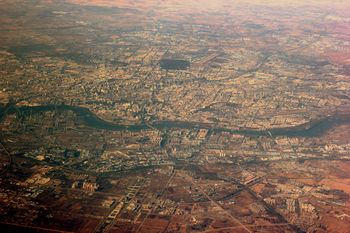
النفوذ الروسي والياباني
بعد الحرب الصينية اليابانية الأولى، قامت اليابان، كـَرهاً، بضم شبه جزيرة لياودونگ عبر معاهدة شيمونوسكي في 1895، إلا أنها أُجبِرت على التنازل عنها بضغوط دبلوماسية من التدخل الثلاثي. في أعقاب التهديد الياباني، زار نائب ملك أسرة تشينگ لي هونگ ژانگ موسكو في 1896 و وقع معاهدة سرية مع وزير الخارجية الروسي ألكسي لوبانوف-روستوڤسكي، تسمح لروسيا الإمبراطورية ببناء سكة حديدية بعرض قضبان روسي في منشوريا، مما فتح الباب لمزيد من التوسع الروسي في شكل another lease convention in 1898, effectively allowing Russia to annex Northeast China in all but name. However, after the Boxer Rebellion in 1900, Russian forces used the anti-foreigner insurgency as a pretext to formally invade and occupied most of Manchuria, and Mukden became a Russian stronghold in the Far East with the building of the South Manchurian Railway.[17][18]
خلال الحرب الروسية اليابانية (1904—1905)، كانت موكدن موقع معركة موكدن من 19 فبراير إلى 10 مارس 1905.[19][20] Involving more than 600,000 combat participants, it was the largest battle since the Battle of Leipzig in 1813, and also the largest modern-era battle ever fought in Asia before World War II.[21] Following the Japanese victory, Mukden became one of the chief bases of Japanese presence and economic expansion into southern Manchuria. It also became the government seat of Fengtian province in 1910.[22]
. . . . . . . . . . . . . . . . . . . . . . . . . . . . . . . . . . . . . . . . . . . . . . . . . . . . . . . . . . . . . . . . . . . . . . . . . . . . . . . . . . . . . . . . . . . . . . . . . . . . . . . . . . . . . . . . . . . . . . . . . . . . . . . . . . . . . . . . . . . . . . . . . . . . . . . . . . . . . . . . . . . . . . . .
فترة أمراء الحرب والاحتلال الياباني
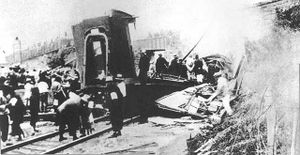
In 1914, the city changed back to its old name Shenyang,[23] but continued to be known as Mukden (sometimes spelled Moukden) in some English sources and in Japan through much of the first half of 20th century. The postmark of the Chinese postal administration kept the spelling "MOUKDEN/奉天" for usage on international mails until the late 1920s. After that, a Chinese–Manchurian bilingual type "SHENYANG (MUKDEN)/瀋陽 (奉天)" datestamp was used until 1933.
In the early 20th century, Shenyang began expanding out of its old city walls. The Shenyang Railway Station on the South Manchurian Railway and the Shenyang North Railway Station on the Jingfeng Railway, both west of the old city, became the new commercial centers of Shenyang.[24] In the 1920s, Mukden was the capital of the warlord Zhang Zuolin, who was later assassinated when his train was blown up on 4 June 1928[25] at a Japanese-guarded railway bridge.[26] At the time, several factories were built by Zhang to manufacture ammunition in the northern and eastern suburbs. These factories laid the foundation for Shenyang's industrial development.[27]
At around 10:20 pm on 18 September 1931, a small quantity of dynamite was detonated close to a railway line near Mukden owned by the Japanese South Manchuria Railway Company by Kwantung Army Lt. Kawamoto Suemori.[28][29] The Imperial Japanese Army, accusing Chinese dissidents of the act, then used the false flag explosion as pretext to launch a full attack on Mukden, and captured the city the following morning (September 19).[29][30] After the Mukden Incident, the Japanese further invaded and occupied the rest of Northeast China, and created the puppet state of Manchukuo with the deposed emperor Aisin Gioro Puyi as the figurehead.[31] During the Manchukuo era (1932–1945), the city was again called Fengtian (and Mukden in English),[32] and was developed by the Japanese into a center of heavy industry.[32][33] Japan was able to exploit resources in Manchuria using the extensive network of railroads.[34] For example, vast expanses of Manchurian forest were chopped down.[35] The development of Shenyang was also unbalanced in this period; municipal facilities were mostly located in Japanese residential areas, while Chinese residential areas had poor living conditions.[33]
ما بعد الحرب العالمية الثانية
Under Marshal of the Soviet Union Aleksandr Vasilevsky, the Far East Command[36] of the Red Army occupied Manchuria in early August 1945 following the surrender of Japan.[37] On 16 August 1945, Manchurian Emperor Puyi was captured in Shenyang Airport by the Soviets while he was in an airplane fleeing to Japan.[38] On 20 August, Soviet troops captured Shenyang. British and US reports indicate that the Soviet troops that occupied Northeast China and Eastern Inner Mongolia region looted and terrorized the people of Shenyang, and were not discouraged by Soviet occupation authorities from "three days of rape and pillage".[39][40][41][42][43][44][45][46][47]
The Soviets were replaced by the Republic of China Army, who were flown in on U.S. transport planes.[48] During the Chinese Civil War, Shenyang remained a Kuomintang stronghold supplied by Claire Lee Chennault's Civil Air Transport from 1946 to 1948, although the Chinese Communist Party controlled the surrounding countryside.[49][50] By February 1948 the city was suffering from drastic shortages, and by the summer 140,000 refugees per month were fleeing. It was captured by the People's Liberation Army on October 30, 1948, following a series of offensives led by Lin Biao known as the Liaoshen Campaign.[49][45][51]
Over the past 200 years or so, Shenyang managed to grow and increase its industrial might during consecutive wars with Russia and Japan in the late 19th and early 20th centuries, the Second World War, and China's Civil War (Shenyang became the main battleground between the Communists and Nationalists).
القرن 21
Directed by state efforts to reduce pollution and close unprofitable industry, the city has undergone deindustrialization, with the shutdown of large plants.[52][53] Most notably, a large 1930s smelter in the central city was closed in 2000.[54][55] The redevelopment of former polluted industrial land has resulted in gentrification.[56]
المدينة القديمة
The old city of Shenyang resided almost entirely within the modern day Shenhe District, and used to have two city walls.[57]
Situated roughly within the area bounded by the four "Shuncheng" (顺城؛ 'along the city'�) roads/streets in Shenhe District, the (now-demolished) square-shaped inner city wall marked the bounds of ancient Shenyang. The earliest wall was built in 926 during early Liao dynasty to settle Northern Song civilians the Khitans abducted from raids to use as slave labourers, and was then made of rammed earth because the city was merely a small settlement at the time (historically the administrative center of the Liaodong region was at Liaoyang). However, in 1368, Hongwu Emperor of the newly founded Ming dynasty ordered a new regional military command—the Liaodong Regional Military Commission (遼東都指揮使司�)—to be established, and Shenyang was made a prominent regional "guard town" (衛所�). In 1388, Min Zhong (閔忠�), the newly appointed city commissioner of the Shenyang Central Guard, wrote to Hongwu Emperor immediately upon his tenure requesting permission to upgrade the city wall, and the old wall was made taller and thoroughly reinforced with overlaid bricks. According to History of Ming, the reconstructed Ming-era wall was 2.5 zhàng (8 metres or 26 feet) tall, more than 1 zhàng (3.2 metres or 10.5 feet) wide at the top, and 9 li and 30 bu (about 5.2 kilometres or 3.2 miles) long. It has two layers of moats dug outside, each being 3 zhàng (9.6 metres or 31.5 feet) wide and 8 chi (2.56 metres or 8 feet 4.8 inches) deep, fed with water from the Little Shen River (the present day South Canal). There were four city gates, each at the center of one side, connected by two main roads that intersected at Central Temple of the city's center in a "+" fashion.
This Ming wall was heavily damaged in 1625 when the Manchus laid siege and captured the city, with only the north wall and gate tower (which had undergone reinforcing reconstructions in 1545 under the orders of Jiajing Emperor) remained intact. The Manchu leader Nurhachi however saw the city's strategic value and decided to formally relocate his Later Jin capital from Liaoyang to Shenyang, and ordered the wall to be rebuilt. According to Annals of Mukden (盛京通志�), the new city wall was a standard black brick wall standing at a height of 3.5 zhàng (about 12.5 metres or 41.0 feet), a width of 1.8 zhàng (about 6.4 metres or 21.0 feet) and a total length of 9 li and 332 bu (about 6.4 kilometres or 4.0 miles), complete with 12 towers (8 gates and 4 corners) and a widened 14.5-zhàng (about 52-metre or 171-foot) moat. The city gates were increased from four to eight, though the old Ming-era north gate tower was preserved but sealed shut, later known as the "Ninth Gate" (九門�).
The outer city wall, called the "peripheral wall" (邊牆؛ Biān Qiáng�) or "pass wall" (關牆؛ Guān Qiáng�), was actually a rammed earth rampart built in 1680 to expand the urban area outside the inner city. It was almost round in shape, standing at a height of 7.5 chi (around 2.7 metres or 8 feet 10.3 inches) and an overall length of 32 li and 24 bu (about 20.7 kilometres or 12.9 miles), and also had eight towerless gates known as the "peripheral gates" (邊門؛ Biān Mén�). The corresponding inner and outer gates were linked by roads that intersected within the inner city in a "#" pattern around the Mukden Palace.
Nearly all of these city walls and gates were demolished after 1949. Two gates and one corner tower of the inner wall were rebuilt during the 1990s. There had, however, been proposals to rebuild the other gates and towers in preparation to the 12th National Games in 2013.
Around 2.5 km (1.6 mi) outside Shenyang's former outer wall, there were four pagodas each located within an associated Tibetan Buddhist temple, namely the East Pagoda in Yongguang Temple (永光寺�), the South Pagoda in Guangci Temple (廣慈寺�), the West Pagoda in Yanshou Temple (延壽寺�) and the North Pagoda in Falun Temple (法輪寺�). They were built in 1643 and completed in 1645. The four pagodas are identical white Buddha-stupas as tall as 26 m (85 ft). Nowadays only the temple for the North Pagoda is well preserved, the East and South has only the pagodas left, and the temple for the West Pagoda was rebuilt in 1998.
Both the Temple of Heaven and Temple of Earth were also to be found in the old city during the Qing dynasty. They were smaller replicas of Beijing's counterparts. Neither exists today.
. . . . . . . . . . . . . . . . . . . . . . . . . . . . . . . . . . . . . . . . . . . . . . . . . . . . . . . . . . . . . . . . . . . . . . . . . . . . . . . . . . . . . . . . . . . . . . . . . . . . . . . . . . . . . . . . . . . . . . . . . . . . . . . . . . . . . . . . . . . . . . . . . . . . . . . . . . . . . . . . . . . . . . . .
الجغرافيا
Shenyang ranges in latitude from 41° 11' to 43° 02' N and in longitude from 122° 25' to 123° 48' E, and is located in the central part of Liaoning province. The western parts of the city's administrative area are located on the alluvial plain of the Liao River system, while the eastern part consists of the hinterlands of the Changbai Mountains, and is covered with forests.[58] The highest point in Shenyang is 414 m (1,358 ft) above sea level and the lowest point only 7 m (23 ft).[59] The average elevation of the urban area is 45 m (148 ft).[60]
The city's main urban area is located to the north of Hun River, formerly the largest tributary of the Liao River proper and often locally referred as the city's "mother river". The central urban area is surrounded by three artificial rivers — respectively the South Canal (南运河) from the south and southeast, the Xinkai River (新开河, formerly the North Canal) from the north and northeast, and the Weigong River (卫工河, formerly the Weigong Nullah) from the west, all interconnected by channels as a continuous waterway. The South Canal in particular, famous for the series of linear parks and gardens along it, was canalized from the old course of the Wanquan River (萬泉河؛ 'ten thousand springs river'�), historically also called the Little Shen River (小瀋水�) or Wuli River (五里河؛ 'five-li river'�), which was a principal water source for the old city.[61] These are reinforced on the peripheries by smaller rivers such as Xi River (细河), Puhe River (蒲河) and Mantang River (满堂河), and drains into the Hun River at three different locations on the southeast, due south and southwest side of the city. There was also previously another canal on the east side called Huishan Nullah (辉山明渠) that drains into Xinkai River's lower section, but is now no longer existent due to land reclamation from urban constructions.
البيئة
Shenyang has many parks, among the most famous are the 14.5 km (9.0 mi) South Canal Linear Parks (南运河带状公园�) situated along the homonymous river traversing the southern parts of Dadong, Shenhe and Heping District, covering an area of approximately 1,400,000 m2 (350 acres). It comprises 6 large parks and 18 riverside gardens, with exotic variety of vegetations such as rose, apricot, bladder cherry, honeylocust, natal lily, scarlet sage, morning glory and black-eyed-Susan, and extensive greenspaces of peach, pear, crabapples, ginkgos, weeping willows, pines and black locusts.[61] It is the largest stretch of vegetated urban open space in Shenyang, contributing significantly to the city's current 40 percent "greening ratio", and was instrumental in the city being awarded the "national forest city" title in 2005.
According to the Shenyang Environmental Protection Bureau, winter usage of coal by boiler stations for hydronic district heating is the source of 30 percent of the air pollution in Shenyang. Half of the 16 million metric tons of coal consumed by the city during the winter of 2013–2014 were used for heating. Other major factors include dust from construction sites (20 percent), vehicle exhaust (20 percent), industrial emissions (10 percent) and extraterritorial dust (20 percent, mostly yellow dust from Gobi Desert). However, air quality was described by the Bureau as "slowly improving".[62]
المناخ
| شنيانگ | ||||||||||||||||||||||||||||||||||||||||||||||||||||||||||||
|---|---|---|---|---|---|---|---|---|---|---|---|---|---|---|---|---|---|---|---|---|---|---|---|---|---|---|---|---|---|---|---|---|---|---|---|---|---|---|---|---|---|---|---|---|---|---|---|---|---|---|---|---|---|---|---|---|---|---|---|---|
| جدول طقس (التفسير) | ||||||||||||||||||||||||||||||||||||||||||||||||||||||||||||
| ||||||||||||||||||||||||||||||||||||||||||||||||||||||||||||
| ||||||||||||||||||||||||||||||||||||||||||||||||||||||||||||
| بيانات مناخ شنيانگ (normals 1971–2000, extremes 1961–2000) | |||||||||||||
|---|---|---|---|---|---|---|---|---|---|---|---|---|---|
| الشهر | يناير | فبراير | مارس | أبريل | مايو | يونيو | يوليو | أغسطس | سبتمبر | اكتوبر | نوفمبر | ديسمبر | العام |
| العظمى القياسية °س (°ف) | 4.8 (40.6) |
14.5 (58.1) |
20.0 (68) |
29.3 (84.7) |
34.3 (93.7) |
39.3 (102.7) |
36.1 (97) |
35.7 (96.3) |
32.7 (90.9) |
29.2 (84.6) |
12.8 (55) |
5.5 (41.9) |
39٫3 (102٫7) |
| العظمى المتوسطة °س (°ف) | −4.8 (23.4) |
−0.9 (30.4) |
6.8 (44.2) |
16.5 (61.7) |
23.0 (73.4) |
27.2 (81) |
29.1 (84.4) |
28.4 (83.1) |
23.6 (74.5) |
15.7 (60.3) |
5.7 (42.3) |
−1.9 (28.6) |
14٫0 (57٫3) |
| المتوسط اليومي °س (°ف) | -11.0 (12.2) |
-6.9 (19.6) |
1.2 (34.2) |
10.2 (50.4) |
17.1 (62.8) |
22.0 (71.6) |
24.7 (76.5) |
23.6 (74.5) |
17.5 (63.5) |
9.5 (49.1) |
0.3 (32.5) |
-7.5 (18.5) |
8٫4 (47٫1) |
| الصغرى المتوسطة °س (°ف) | −16.1 (3) |
−12.2 (10) |
−3.8 (25.2) |
4.2 (39.6) |
11.2 (52.2) |
17.0 (62.6) |
20.6 (69.1) |
19.3 (66.7) |
12.1 (53.8) |
4.2 (39.6) |
−4.2 (24.4) |
−12.1 (10.2) |
3٫4 (38٫0) |
| الصغرى القياسية °س (°ف) | −33.1 (-27.6) |
−27.2 (-17) |
−21.7 (-7.1) |
−12.5 (9.5) |
0.2 (32.4) |
6.9 (44.4) |
12.4 (54.3) |
8.0 (46.4) |
1.0 (33.8) |
−8.3 (17.1) |
−22.5 (-8.5) |
−30.2 (-22.4) |
−33٫1 (−27٫6) |
| هطول mm (inches) | 6.0 (0.236) |
7.0 (0.276) |
17.9 (0.705) |
39.4 (1.551) |
53.8 (2.118) |
92.0 (3.622) |
165.5 (6.516) |
161.8 (6.37) |
74.7 (2.941) |
43.3 (1.705) |
19.2 (0.756) |
9.8 (0.386) |
690٫4 (27٫181) |
| % Humidity | 60 | 55 | 53 | 52 | 55 | 67 | 78 | 78 | 71 | 65 | 63 | 61 | 63٫2 |
| Avg. precipitation days (≥ 0.1 mm) | 3.5 | 4.0 | 5.1 | 7.7 | 9.2 | 11.9 | 13.5 | 10.9 | 7.6 | 6.7 | 5.4 | 3.8 | 89٫3 |
| Sunshine hours | 162.5 | 179.3 | 221.8 | 236.3 | 256.0 | 238.6 | 206.8 | 218.8 | 228.4 | 212.3 | 161.0 | 146.2 | 2٬468 |
| Source: China Meteorological Administration,[63] all-time extreme temperature[64] | |||||||||||||
أحياء ومناطق المدينة
| الخريطة | ||||||
|---|---|---|---|---|---|---|
| الاسم | الصينية المبسطة | هانيو پنين | التعداد (2010) |
المساحة (كم²) | الكثافة (/كم²) | |
| المدينة نفسها | ||||||
| مديرية شنهى | 沈河区 | Shěnhé Qū | 849,267 | 18 | 47,182 | |
| مديرية هىپـِنگ | 和平区 | Hépíng Qū | 700,992 | 21 | 33,381 | |
| Dadong District | 大东区 | Dàdōng Qū | 782,867 | 51 | 15,350 | |
| Huanggu District | 皇姑区 | Huánggū Qū | 925,176 | 37 | 25,005 | |
| Tiexi District | 铁西区 | Tiěxī Qū | 1,017,564 | 39 | 26,091 | |
| الضواحي | ||||||
| Sujiatun District | 苏家屯区 | Sūjiātún Qū | 474,779 | 776 | 612 | |
| مديرية هوننان | 浑南区 | Húnnán Qū | 411,110 | 896 | 459 | |
| Shenbei New District | 沈北新区 | Shěnběi Xīnqū | 423,323 | 852 | 497 | |
| Yuhong District | 于洪区 | Yúhóng Qū | 670,843 | 774 | 867 | |
| Liaozhong District | 辽中区 | Liáozhōng Qū | 476,081 | 1,670 | 285 | |
| المدن الساتلة | ||||||
| Xinmin | 新民市 | Xīnmín Shì | 657,763 | 3,315 | 198 | |
| الريف | ||||||
| Kangping County | 康平县 | Kāngpíng Xiàn | 316,819 | 2,173 | 146 | |
| ناحية فاكو | 法库县 | Fǎkù Xiàn | 399,587 | 2,320 | 172 | |
مديرية شنهى
مديرية هىپـِنگ (和平区/和平區 Hépíng Qū)
مناطق التسوق
الاقتصاد

Shenyang is an important industrial center in China and is the core city of Shenyang Economic Zone, a New Special Reform Zone. It has been focused on heavy industry, particularly aerospace, machine tools, heavy equipment and defence, and recently on software, automotive and electronics.[67][67] The heavy industry started in the 1920s and was well developed before the second world war.[68][69] During the first five-year plan (1951–1956) many factories were built in Tiexi district.[70] At its peak in the 1970s, Shenyang was one of the top three industrial centers in China alongside Shanghai and Tianjin, and was at one time being considered for upgrading to a direct-controlled municipality. However, as the planned economy fell out of favor after the 1980s, the heavy industry had declined gradually and the city became a rust belt city, with hundreds of thousands of people laid off from bankrupted state-owned factories.[71][72][73] However, the economy of the city has revived significantly in recent years, thanks to the central government's "Revitalize Northeast China" campaign and the rapid development of software and auto manufacture industries.[74] Investment subsidies are granted to multinational corporations (MNCs) that set up offices or headquarters in Shenyang.[75]
The services sector — especially banking — has been developing in Shenyang. Shenyang has several foreign banks, such as South Korea's Hana Bank, Japan's Bank of Tokyo-Mitsubishi UFJ, Hong Kong's Bank of East Asia, Singapore's United Overseas Bank and the Britain-based HSBC. In 2006, the city hosted a total of 1,063 banks and bank branches and 144 insurance-related companies. By 2010, it aims to attract 30 foreign banks and 60 non-bank financial institutions.[75][needs update]
The city has been identified by the Economist Intelligence Unit in the November 2010 Access China White Paper as a member of the CHAMPS (Chongqing, Hefei, Anshan, Maanshan, Pingdingshan and Shenyang), an economic profile of the top 20 emerging cities in China.[76]
Shenyang has three development zones:
- Shenyang Finance and Trade Development Zone
- Shenyang High-Tech Industrial Development Zone
- Shenyang Economic & Technological Development Zone
Numerous major industrial companies have their headquarters in Shenyang. Brilliance Auto is a major Chinese automobile manufacturer, and most of its production plants are also located in Shenyang.[77][78] Shenyang Aircraft Corporation produces airplanes for civilian use as well as for the PLAAF.[79] Neusoft Group is the biggest software company in China.[80] Shenyang Machine Tool Group is the largest machine tool manufacturer in China.[81] Tyco International, General Motors and Michelin Shenyang Tyre Corporation are expanding their operations in Shenyang.
The total GDP of the city of Shenyang is 383.66 billion yuan in year 2009 (ranked 1st out of the 58 cities and counties in Liaoning province). The GDP per capita of the city of Shenyang is 78490 yuan in 2009 (ranked 3rd out of all 58 cities and counties in Liaoning province).[82]
المدن الشقيقة
المدن التالية مشاركة في توأمة البلدات مع شنيانگ:
 ساپورو، اليابان (1980)
ساپورو، اليابان (1980) كاواساكي، اليابان (1981)
كاواساكي، اليابان (1981) تورينو، إيطاليا (1985)
تورينو، إيطاليا (1985) شيكاغو، الولايات المتحدة (1985)
شيكاغو، الولايات المتحدة (1985) إركوتسك، روسيا (1992)
إركوتسك، روسيا (1992) كويزون سيتي، الفلپين (1993)
كويزون سيتي، الفلپين (1993) رمات گان، إسرائيل (1993)
رمات گان، إسرائيل (1993) Monterrey، المكسيك (1993)
Monterrey، المكسيك (1993) Seongnam، كوريا الجنوبية (1998)
Seongnam، كوريا الجنوبية (1998) ياونده، الكامرون (1998)
ياونده، الكامرون (1998) Katowice، پولندا (2007)
Katowice، پولندا (2007) Gumi, South Korea
Gumi, South Korea لڤركوزن، ألمانيا
لڤركوزن، ألمانيا دوسلدورف، ألمانيا
دوسلدورف، ألمانيا
انظر أيضاً
المصادر
- ^ 行政区划 [Administrative division] (in الصينية المبسطة). Liaoning People's Government. Archived from the original on 7 نوفمبر 2018. Retrieved 1 أكتوبر 2018.
截至2016年底,辽宁省辖14个地级市(其中沈阳、大连为副省级城市)、{...}
- ^ "China: Liáoníng (Prefectures, Cities, Districts and Counties) - Population Statistics, Charts and Map".
- ^ أ ب 2017年沈阳市国民经济和社会发展统计公报 (in الصينية المبسطة). Shenyang City People's Government. June 2018. Archived from the original on 2018-06-27. Retrieved 2018-06-19.
- ^ خطأ استشهاد: وسم
<ref>غير صحيح؛ لا نص تم توفيره للمراجع المسماة:1 - ^ 2020 census
- ^ "Illuminating China's Provinces, Municipalities and Autonomous Regions-Liaoning". PRC Central Government Official Website. 2001. Archived from the original on 2014-03-03. Retrieved 2014-04-22..
- ^ خطأ استشهاد: وسم
<ref>غير صحيح؛ لا نص تم توفيره للمراجع المسماةEbrey2010pp220224 - ^ 陈海波:坚定不移朝着建设先进装备制造业基地目标加速前行 (in الصينية). Shenyang People's Government. 2013-03-06. Archived from the original on 2013-09-27. Retrieved 2013-04-28.
- ^ 沈阳. Xinhua (in الصينية). 2012-10-09. Archived from the original on 2013-12-08. Retrieved 2013-11-21.
- ^ 东北地区振兴规划 (in الصينية). China State Council. Archived from the original on 22 أغسطس 2010. Retrieved 31 أغسطس 2010.
- ^ "Nature Index 2020 Science Cities | Supplements | Nature Index". www.natureindex.com. Retrieved 2020-10-16.
- ^ 顾奎相 (January 2013). 沈阳名称由来考——因"沈水"而得名,非"合成"说. 《理论界》 (1).
- ^ Archaeology of Asia, pp.129
- ^ Ebrey (2010), pp. 220–224.
- ^ أ ب ت 盛京城史话 (in الصينية). 辽宁省档案信息网. Archived from the original on 2013-12-02. Retrieved 2014-05-28.
{{cite web}}: Unknown parameter|dead-url=ignored (|url-status=suggested) (help) - ^ 三陵巷 三陵衙门和盛京将军 (in الصينية). 中国经济网. Archived from the original on 2013-05-15. Retrieved 2013-05-01.
{{cite web}}: Unknown parameter|deadurl=ignored (|url-status=suggested) (help) - ^ The Century illustrated monthly magazine, Volume 68. NEW YORK: The Century Co. 1904. p. 581. Retrieved 2011-07-06.(Original from Harvard University)
- ^ Making of America Project (1904). The Century: a popular quarterly, Volume 68. NEW YORK: Scribner & Co. p. 581. Retrieved 2011-07-06.(Original from the University of Michigan)
- ^ Palmer, Colton & Kramer 2007, p. 673
- ^ Spencer C. Tucker (23 December 2009). A Global Chronology of Conflict: From the Ancient World to the Modern Middle East: From the Ancient World to the Modern Middle East. ABC-CLIO. p. 1542. ISBN 978-1-85109-672-5. Retrieved 27 April 2013.
- ^ Menning p.187
- ^ 刘思铎、陈伯超 (2013). "奉天省咨议局建筑特点研究". 《华中建筑》 (4).
{{cite journal}}:|access-date=requires|url=(help); Cite has empty unknown parameter:|coauthors=(help) - ^ 沈阳市沈河区外经贸之窗. Ministry of Commerce, Shenhe District. Archived from the original on 2013-12-21. Retrieved 2014-05-29.
- ^ 追溯沈阳行政区划的百年印记. 《沈阳晚报》. 2013-10-29. Archived from the original on 2013-12-24. Retrieved 2014-05-29.
- ^ Hata 288
- ^ 日本早期对华侵略:皇姑屯事件. Xinhua. Archived from the original on 2013-12-30. Retrieved 2014-05-29.
- ^ 李彤 (2009-02-12). 奉天军械厂. 《沈阳日报》. Archived from the original on 2013-12-28. Retrieved 2014-05-29.
- ^ The Cambridge History of Japan: The twentieth century, p. 294, Peter Duus, John Whitney Hall, Cambridge University Press: 1989. ISBN 978-0-521-22357-7
- ^ أ ب 82年前"九一八". 《石家庄日报》. 2013-09-16. Archived from the original on 2014-11-30. Retrieved 2014-05-29.
- ^ Behr, Edward (1987). The Last Emperor. Bantam. p. 182. ISBN 0-553-34474-9.
- ^ Fenby, Jonathan. Chiang Kai-shek: China's Generalissimo and the Nation He Lost. Carroll & Graf: 2003, p. 202
- ^ أ ب 詹德华 (2012-04-06). 初建,一个工业区的诞生. 《沈阳晚报》. Archived from the original on 2012-04-12. Retrieved 2014-05-29.
- ^ أ ب 卫岚. 沈阳四次编制城市总体规划. 东北新闻网. Archived from the original on 2013-12-24. Retrieved 2014-05-29.
- ^ 辽宁沈阳简介. 农业部都市重点实验室. Archived from the original on 2013-12-12. Retrieved 2014-05-29.
- ^ Prasenjit Duara. "The New Imperialism and the Post-Colonial Developmental State: Manchukuo in comparative perspective". Archived from the original on 16 يونيو 2010. Retrieved 25 يوليو 2010.
- ^ "Battlefield – Manchuria – The Forgotten Victory", Battlefield (documentary series), 2001, 98 minutes.
- ^ LTC David M. Glantz, "August Storm: The Soviet 1945 Strategic Offensive in Manchuria" Archived مارس 3, 2016 at the Wayback Machine. Leavenworth Papers No. 7, Combat Studies Institute, February 1983, Fort Leavenworth Kansas.
- ^ Mydans, Seth (11 June 1997). "Li Shuxian, 73, Widow of Last China Emperor". The New York Times.
- ^ Christian Science Monitor, 12 October 1945.
Japanese armies were guilty of appalling excesses, both in China and elsewhere, and had the Russians dealt harshly with only Japanese nationals in Manchuria this would have appeared as just retribution. But the indiscriminate looting and raping inflicted upon the unoffending Chinese by the Russians naturally aroused the keenest indignation. - ^ F. C. Jones (1949). "Chapter XII – Events in Manchuria, 1945–47". Manchuria since 1931 (PDF). London, Oxford University Press: Royal Institute of International Affairs. pp. 224–5, 227–9. Archived from the original (PDF) on 2013-12-19. Retrieved 2014-02-12. (The relevant sections also appear at Talk:Soviet invasion of Manchuria/Events in Manchuria, 1945-47)
- ^ Hannah Pakula (2009). The last empress: Madame Chiang Kai-Shek and the birth of modern China. Simon and Schuster. p. 530. ISBN 978-1-4391-4893-8. Retrieved 2014-02-12.
mukden berlin rape and pillage.
- ^ Dieter Heinzig (2004). The Soviet Union and communist China, 1945–1950: the arduous road to the alliance. M.E. Sharpe. p. 82. ISBN 0-7656-0785-9. Archived from the original on 2014-06-17. Retrieved 2014-02-12.
- ^ Robyn Lim (2003). The geopolitics of East Asia: the search for equilibrium. Psychology Press. p. 86. ISBN 0-415-29717-6. Archived from the original on 2011-12-14. Retrieved 2010-11-28.
- ^ Ronald H. Spector (2008). In the Ruins of Empire: The Japanese Surrender and the Battle for Postwar Asia. Random House, Inc. p. 33. ISBN 978-0-8129-6732-6. Archived from the original on 2014-06-17. Retrieved 2014-02-12.
- ^ أ ب Yu Huating (于化庭) (2008)
- ^ 1948年,沈阳解放改变了中国与世界. 《沈阳晚报》 (in الصينية المبسطة). 2013-10-29. Archived from the original on 2014-10-23. Retrieved 2013-12-21.
- ^ 1948年11月2日 沈阳解放. 中国新闻周刊网. Archived from the original on 2013-12-14. Retrieved 2014-05-29.
- ^ Zhang Mingjin (張明金); Liu Liqin (劉立勤) (2007). 《國民黨歷史上的158個軍》. Beijing: 解放軍出版社.
{{cite book}}: CS1 maint: multiple names: authors list (link) CS1 maint: numeric names: authors list (link) - ^ أ ب Dikötter, Frank. (2013). The Tragedy of Liberation: A History of the Chinese Revolution, 1945-1957 (1 ed.). London: Bloomsbury Press. ISBN 978-1-62040-347-1.
- ^ Zhu Yuepeng (朱悦鹏). 《东北解放战争纪实》 (in الصينية المبسطة). Beijing: 长征出版社.
{{cite book}}: CS1 maint: multiple names: authors list (link) CS1 maint: numeric names: authors list (link) - ^ 文史资料研究委员会 (April 1992). 辽沈战役亲历记 -原国民党将领的回忆 (in الصينية المبسطة) (1992年版 ed.). Beijing: Chinese Literature and History Press. ISBN 7-5034-0559-7.
- ^ Gao, Shuyi (2017). Emerging Identity: Envisioning Eco-cultural Infrastructure in Post Industrial Shenyang, China (MLA thesis) (in الإنجليزية الأمريكية). University of Washington.
- ^ Shin, Sangbum (2004). "Economic Globalization and the Environment in China: A Comparative Case Study of Shenyang and Dalian". The Journal of Environment & Development. 13 (3): 263–294. doi:10.1177/1070496504268352. ISSN 1070-4965. JSTOR 44319696. S2CID 154554360.
- ^ Byrd, William. "The Shenyang smelter : a case study of problems and reforms in China's nonferrous metals industry" (PDF). World Bank Staff Working Papers. 766 (in English). World Bank.
{{cite journal}}: CS1 maint: unrecognized language (link) - ^ "Shenyang Shuts Down Polluting Smelter". People's Daily. Retrieved 2022-07-26.
- ^ Tomba, Luigi (2017-08-21). "Gentrifying China's Urbanization? Why Culture and Capital Aren't Enough: Interventions". International Journal of Urban and Regional Research (in الإنجليزية). 41 (3): 508–517. doi:10.1111/1468-2427.12494.
- ^ "Map of Mukden in 1912". Archived from the original on 2010-02-14. Retrieved 2010-01-22.
- ^ 沈阳区域地质概述. Shenyang Planning and Land and Resources Bureau (沈阳市规划和国土资源局). Archived from the original on 2014-02-19. Retrieved 2014-02-02.
- ^ 沈城母亲河:水光异彩 璀璨浑河. 中国青年网. Archived from the original on 2013-11-06. Retrieved 2013-12-14.
- ^ 孙鸿金 (2012). 近代沈阳城市发展与社会变迁 (博士 thesis).
- ^ أ ب 南运河的今与昔 (in الصينية). Shenhe District People's Government. Archived from the original on 2016-11-01. Retrieved 2016-10-31.
- ^ Liu Ce (نوفمبر 13, 2013). "Coal for heating identified as top air polluter in NE China". China Daily. chinadaily.com.cn. Archived from the original on سبتمبر 24, 2015. Retrieved ديسمبر 10, 2014.
- ^ أ ب
中国地面国际交换站气候标准值月值数据集(1971-2000年) (in Chinese). China Meteorological Administration. Archived from the original on 2013-09-21. Retrieved 2010-01-22.
{{cite web}}: Unknown parameter|deadurl=ignored (|url-status=suggested) (help)CS1 maint: unrecognized language (link) - ^ خطأ استشهاد: وسم
<ref>غير صحيح؛ لا نص تم توفيره للمراجع المسماةMherrera - ^ 高薇 (2007-07-02). "沈阳中街步行街东延2公里 全长3.5公里". 《沈阳晚报》. Retrieved 2014-06-27.
- ^ "中街"东拓西延"成最长商业街-新闻频道-手机搜狐". m.sohu.com. Retrieved 2016-11-21.
- ^ أ ب 刘妮. "沈阳:"共和国装备部"重新"工业立市"". 《南风窗》. Archived from the original on 2013-12-14. Retrieved 2013-12-04.
{{cite journal}}: Cite has empty unknown parameter:|coauthors=(help); Unknown parameter|deadurl=ignored (|url-status=suggested) (help) - ^ "沈阳兵工厂". 火器堂. Retrieved 2013-11-22.
- ^ "沈阳解放-中国共产党新闻". 人民网. Retrieved 2013-04-30.
- ^ 张毅 (2013-11-19). "1953,沈阳人的黄金小时代". 《沈阳晚报》. Archived from the original on 2013-12-13. Retrieved 2013-11-22.
{{cite news}}: Unknown parameter|deadurl=ignored (|url-status=suggested) (help) - ^ 皮树义,孙健,何勇,陈仁泽 (2012-07-30). "东北振兴看沈阳". 《人民日报》. Archived from the original on 2013-03-20. Retrieved 2013-12-04.
{{cite news}}: Unknown parameter|deadurl=ignored (|url-status=suggested) (help) - ^ "沈阳铁西:新型工业化引领发展". 《工人日报》. 2013-02-01. Archived from the original on 2013-05-21. Retrieved 2013-12-07.
- ^ 何勇 (2008-10-29). "沈阳——国企破产在这里"破题"". 《人民日报》. Retrieved 2014-02-01.
- ^ "国务院将成立东北办公室". 中国网. Retrieved 2013-04-30.
- ^ أ ب "china business review". china business review. 2009. Archived from the original on 2012-07-10. Retrieved 2010-03-22.
{{cite web}}: Unknown parameter|deadurl=ignored (|url-status=suggested) (help) - ^ "The Rise Of The 'Champs' – New Report Maps Business Opportunity In China's Fastest Growing Cities". Sourcewire.com. 2010-11-09. Retrieved 2011-03-29.
- ^ "2012年沈阳市国民经济和社会发展统计公报". 《沈阳日报》. 2013-05-19. Retrieved 2014-01-22.
- ^ "宝马开启沈阳时代". 日经中文网. Retrieved 2014-03-23.
- ^ "沈阳飞机工业(集团)有限公司". 人民网. Retrieved 2013-12-09.
- ^ 杨吉平 (2005-03-29). "东软集团成为最大软件外包提供商". 《光明日报》. Retrieved 2013-12-09.
- ^ 熊建 林丽鹂 罗艾桦 何勇 (2008-07-04). "沈阳机床 攀上制高点". 《人民日报》. Archived from the original on 2012-06-18. Retrieved 2013-12-09.
{{cite news}}: Unknown parameter|deadurl=ignored (|url-status=suggested) (help) - ^ Liaoning Statistical Yearbook. 2009.
 "Mukden". Encyclopædia Britannica (11th ed.). 1911.
"Mukden". Encyclopædia Britannica (11th ed.). 1911.
وصلات خارجية
| Shenyang
]].- Articles containing صينية-language text
- CS1 uses الصينية-language script (zh)
- CS1 الصينية المبسطة-language sources (zh-hans)
- CS1 الصينية-language sources (zh)
- Harv and Sfn no-target errors
- CS1 errors: unsupported parameter
- CS1 errors: access-date without URL
- CS1 maint: numeric names: authors list
- CS1 الإنجليزية الأمريكية-language sources (en-us)
- Short description is different from Wikidata
- Pages using multiple image with auto scaled images
- Coordinates on Wikidata
- مقالات تحتوي نصوصاً باللغة الصينية المبسطة
- مقالات تحتوي نصوصاً باللغة الصينية التقليدية
- مقالات تحتوي نصوصاً باللغة الصينية
- Articles containing Manchu-language text
- Wikipedia articles in need of updating from April 2014
- All Wikipedia articles in need of updating
- Articles with hatnote templates targeting a nonexistent page
- شنيانگ
- عواصم المقاطعات في الصين
- عواصم أمم سابقة
- مدن لياوننگ
- Prefecture-level divisions of Liaoning
- National Forest Cities in China
- أماكن مأهولة تأسست في الألفية الأولى ق.م.
- صفحات مع الخرائط

